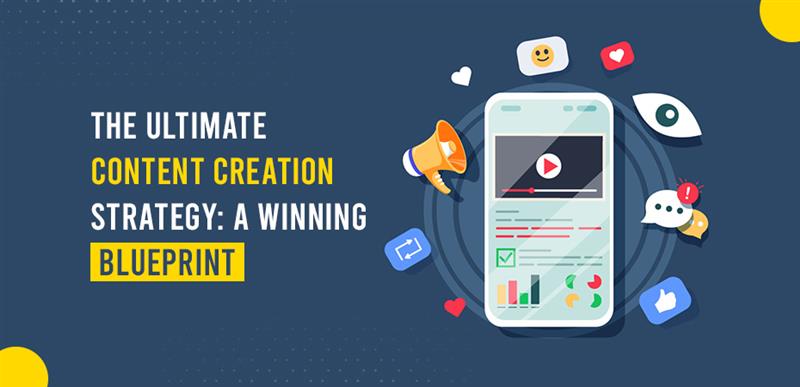The Ultimate Content Creation Strategy: A Winning Blueprint



In today’s competitive digital landscape, having a well-defined content creation strategy is essential for agencies aiming to deliver consistent, high-quality results for their clients. Without a structured approach, content efforts can become scattered, ineffective, and fail to generate real business outcomes.
At White Label SEO Providers, we understand the importance of crafting a content strategy plan that aligns with both search engine algorithms and audience expectations. In this guide, we’ll walk you through the fundamental aspects of digital content strategy, ensuring your agency has a clear roadmap for creating, managing, and optimizing content that drives traffic, engagement, and conversions.
Defining Your Content Goals & Objectives
Before diving into content creation, it’s essential to define clear objectives. A content management strategy should be built around measurable goals that align with business priorities. Whether the aim is to increase brand awareness, generate leads, or establish thought leadership, every piece of content should serve a specific purpose.
Key Considerations for Setting Content Goals:
- Identify Business Priorities: Is the focus on organic traffic, conversions, or brand authority? Each goal influences the type of content created.
- Map Content to the Sales Funnel: Content should cater to different stages of the buyer’s journey—awareness, consideration, and decision.
- Set SMART Goals: Goals should be Specific, Measurable, Achievable, Relevant, and Time-bound to track progress effectively.
For example, an agency working with an e-commerce client may prioritize blog posts that educate potential buyers, while a B2B SaaS company may need in-depth whitepapers to nurture leads. A blog content strategy tailored to each client ensures targeted content that resonates with their audience.
A robust content development strategy also includes performance metrics such as engagement rates, organic traffic, and conversion rates. Without these, agencies risk creating content without a clear sense of impact or direction.
Understanding Your Target Audience
A well-researched strategy and content approach begins with knowing the audience. Content that doesn’t address the needs, challenges, and preferences of the target market is unlikely to perform well, regardless of SEO efforts.
How to Define and Understand Your Audience:
- Develop Detailed Buyer Personas: Create profiles based on demographics, pain points, and online behavior to ensure content relevance.
- Conduct Market Research: Use surveys, social media insights, and competitor analysis to understand what topics interest the audience.
- Analyze Search Intent: Beyond keywords, consider the purpose behind a search query—whether informational, navigational, or transactional.
For instance, a local marketing agency may cater to small businesses looking for affordable digital solutions, while a tech-focused agency may target enterprises needing advanced automation strategies. A tailored content strategy ensures that every piece of content speaks directly to the intended audience.
Agencies should also consider content formats that resonate best with their audience. Some may prefer in-depth blog posts, while others engage more with video content or interactive infographics. Understanding these preferences will guide an effective content development plan.
Keyword Research & SEO Optimization
An effective content strategy plan is incomplete without SEO optimization. Keywords help search engines understand content relevance, making it easier for clients’ websites to rank higher. However, agencies must go beyond just inserting keywords; they must ensure content aligns with user intent.
Key Steps for Effective Keyword Research:
- Use SEO Tools: Platforms like Ahrefs, SEMrush, and Google Keyword Planner can uncover high-impact keywords for content.
- Focus on Long-Tail Keywords: These have lower competition and are more specific, making them ideal for attracting qualified traffic.
- Analyze Competitor Keywords: Studying competitor rankings can reveal opportunities for content improvement.
While keyword research is essential, SEO also involves structuring content effectively. This includes optimizing meta descriptions, headers, and internal linking to enhance readability and search performance.
For example, a well-structured content creation strategy should include clear headings, bullet points, and visuals to improve user experience. Agencies should also integrate internal linking strategies to keep users engaged and reduce bounce rates.
Additionally, the importance of E-E-A-T (Experience, Expertise, Authoritativeness, and Trustworthiness) in Google’s ranking system means that content should provide value, be well-researched, and include credible sources where applicable.
Crafting High-Quality & Engaging Content
Creating content that stands out requires more than just keyword insertion. Quality, originality, and engagement play a crucial role in ensuring that content resonates with the audience. A content development strategy should prioritize well-researched, data-backed, and visually appealing content.
Essential Elements of High-Performing Content:
- Originality & Value: Avoid generic content—ensure every piece offers new insights or unique perspectives.
- Storytelling Approach: Audiences connect better with narratives rather than just facts. Case studies, testimonials, and real-world examples can enhance engagement.
- Content Structure & Readability: Use short paragraphs, subheadings, and bullet points for better readability.
For example, agencies working with SaaS clients should create in-depth product comparisons, while those handling e-commerce clients may focus on visually rich guides. A structured content management strategy ensures that content is easy to consume and actionable.
The choice between evergreen and trending content is another crucial aspect. Evergreen content remains relevant over time, providing long-term value, while trending topics drive short-term spikes in traffic. A balance between both is essential for a well-rounded content development plan.
By focusing on these aspects, agencies can ensure that their clients’ content doesn’t just rank well but also keeps users engaged, reducing bounce rates and increasing conversions.
Choosing the Right Content Formats
One of the most overlooked yet vital aspects of creating a content strategy is choosing the right content formats. Different formats serve different purposes and appeal to various audience preferences. As an agency offering content strategy services, it’s crucial to identify which content types are most effective for your clients’ goals and industries.
Popular Content Formats Agencies Should Leverage:
- Blog Articles: Perfect for SEO, blogs help establish authority and improve organic traffic. Long-form pillar posts and niche-specific how-tos are key components of any effective content generation strategy.
- Video Content: Short-form videos for social media, explainer videos, and webinars increase engagement and are highly shareable.
- Infographics: Great for distilling complex data and improving user retention.
- Podcasts: A rapidly growing medium, podcasts cater to users who prefer audio content on the go.
- E-books & Whitepapers: Excellent lead magnets for B2B clients looking to build credibility.
Understanding your target audience will help you determine which formats to prioritize. For example, for clients with multiple branches or regions, tailoring formats across locations is essential. Our recent post on content strategies for multi-location businesses explores this in detail.
When building a content marketing strategy development framework, include a diverse mix of these formats in your content strategy plan to keep engagement high and cater to various learning styles. Each piece of content, regardless of format, should align with the broader marketing content strategy to ensure cohesion and consistency.
Content Calendar & Planning for Consistency
Consistency is what separates random content publishing from a structured content strategy development plan. This is where a well-organized content calendar comes into play. It helps agencies plan ahead, maintain regular publishing schedules, and avoid last-minute scrambling.
Steps to Build a Content Calendar:
- Brainstorm Topics in Batches: Use keyword research and audience feedback to identify content themes in advance. For instance, understanding keyword difficulty can help prioritize low-competition topics.
- Use Project Management Tools: Tools like Trello, Notion, or Airtable can streamline your content management strategy and allow for easy collaboration.
- Schedule Content Across Platforms: Ensure your calendar includes blog posts, emails, social media, and other formats to maintain a unified approach.
Consistency builds trust, improves SEO rankings, and ensures better engagement over time. It also allows for tracking performance trends and optimizing future content. When agencies apply a thoughtful strategy content approach to planning, it reflects positively on client success.
If you’re wondering how to develop a structured and scalable content publishing process, start by mapping content to goals, assigning deadlines, and repurposing successful pieces across multiple formats. This proactive planning forms the backbone of a sustainable content creation strategy.
Content Distribution & Promotion Strategy
Even the most well-crafted content won’t perform if it doesn’t reach the right audience. Distribution is just as critical as creation. A powerful content marketing strategy development should include a robust promotional plan to get maximum ROI from your efforts.
Effective Distribution Tactics for Agencies:
- Social Media Marketing: Tailor posts for LinkedIn, Instagram, Twitter, or Facebook depending on where your client’s audience lives.
- Email Newsletters: Drive consistent engagement through value-packed emails that guide users back to fresh content.
- Repurposing Content: Transform blog posts into videos, carousel posts, or infographics to multiply their reach.
- Collaborations & Guest Posts: Partnering with other content creators or industry experts increases visibility.
- Paid Ads & Retargeting: Promote high-performing content through PPC campaigns. Learn more about uncovering your competition’s tactics with our guide on PPC spying techniques.
A strategic distribution approach also supports ongoing content strategy development, giving insights into which platforms yield the best returns. Agencies that combine organic and paid promotion effectively ensure that their content efforts deliver measurable outcomes for their clients.
Measuring Performance & Optimization
No content strategy service is complete without a strong focus on analytics and continuous improvement. It’s vital to assess whether the strategy is meeting its goals and where adjustments are needed.
Key Performance Metrics to Monitor:
- Organic Traffic & Rankings: Use tools like Google Search Console to track keyword positions and performance.
- Engagement Rates: Monitor bounce rates, time on page, and social shares to gauge how well content resonates.
- Conversion Metrics: Whether it’s downloads, sign-ups, or purchases, conversion tracking is essential for ROI.
- Content Audit: Periodically review all published content to update, repurpose, or remove outdated posts.
Analyzing these metrics helps agencies refine their content development strategy, doubling down on what works and fixing what doesn’t. It also informs your content creation strategies going forward, ensuring your efforts are always backed by real-world data.
When executed correctly, performance analysis transforms a basic marketing content strategy into a results-driven engine that supports long-term growth. By integrating insights into the ongoing content strategy plan, agencies remain agile and responsive to industry shifts.
Conclusion
In today’s fast-paced digital environment, a strong and scalable content creation strategy isn’t just a nice-to-have—it’s a must. For agencies looking to consistently deliver value to their clients, mastering the art of content strategy development is key to staying competitive and relevant.
For agencies, the real challenge often lies in execution at scale. That’s where White Label SEO Providers comes in. As a trusted partner for agencies nationwide, we help you streamline your entire content strategy service—from planning and content development to promotion and analytics.
We don’t just provide support—we help you build a content engine that delivers results. Our white-label approach means you can offer enterprise-level content strategy solutions to your clients without increasing internal workload or infrastructure.
So, if your agency is ready to elevate its content marketing strategy development and deliver consistent, measurable results, partner with White Label SEO Providers today. Let us help you transform your content into a powerful growth tool—for every client, in every industry.
Explore our full suite of white-label SEO and content solutions at whitelabelseoproviders.us and take the first step toward smarter, data-backed content strategies.
Frequently Asked Questions (FAQs)
A content strategy is a structured plan that outlines how content will be created, managed, and distributed to achieve specific business goals. For agencies, it ensures consistent messaging, drives client engagement, and supports long-term growth.
Agencies can scale by using project management tools, creating a content calendar, repurposing high-performing content, and leveraging white-label partners like White Label SEO Providers to handle execution without increasing internal overhead.
Content development involves the actual creation of content—writing, designing, or producing media—while content strategy focuses on planning, aligning with goals, and ensuring consistent performance across platforms.
Your content strategy should be reviewed quarterly and adjusted based on performance metrics, industry trends, or client feedback to stay relevant and effective.